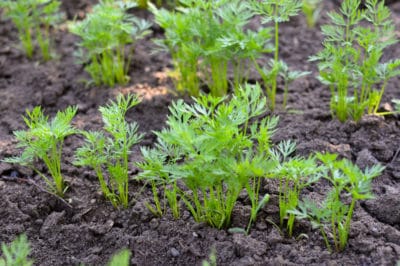When to look for seedlings.
Carrot seeds are usually sown directly into the soil and require heavy watering to germinate; this can take anywhere from one to several weeks. Generally speaking, look for one inch tall seedlings somewhere around three weeks after planting, although it could take a little longer.
What your seedlings will look like.
At first, a carrot seedling looks rather similar to a blade of grass; just a single or double growth of slender green leaf. By the time the plant is an inch or two tall, though, the familiar lacy green carrot top is evident.
When to thin your seedlings.
Carrot seeds are tiny, and are planted very closely together, thus as your seedlings emerge, they will need to be thinned to allow room for growth. Actually, you will thin your carrots twice. The first will be when your seedlings are about three or four inches tall.
To thin the first time, select the seedlings that are smallest, or too close to others. Do not pull your selected seedlings, though; using sharp scissors, cut the seedling at soil level. Pulling seedlings could damage the roots of surrounding carrot plants. When you’re done, your remaining plants should be about a thumb’s width apart.
Thin again a month later; your carrot plants should end up two inches apart. Water first, then use a fork or similar garden tool to loosen the soil around the top of the plant. Grasp the greens at their base and pull. You will likely pull some baby carrots this time; these are edible and delicious!
You can transplant your seedlings.
Carrot seedlings aren’t known for their love of transplantation, but if you’ve got a bunch of thinned plants and a place to put them, give it a try!
- Prepare the soil just as you would for seeds; it needs to be loose, sandy, and well-drained.
- Water well, then place the seedling in the ground carefully.
- The root needs to be inserted into the ground as straight as possible.
- Once the plant is situated, gently mound dirt around the root, making sure it is completely buried.
- A mulch of straw or leaves mixed with organic compost will help feed your plants while helping retain water in the soil.
Your carrot seedlings need proper care to grow to maturity. Luckily, only a little work is needed to raise a plentiful harvest.
